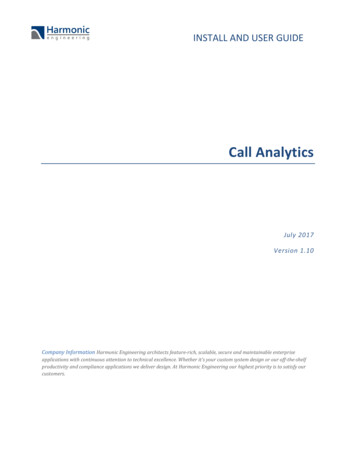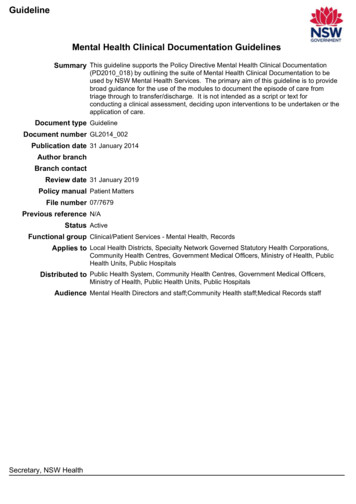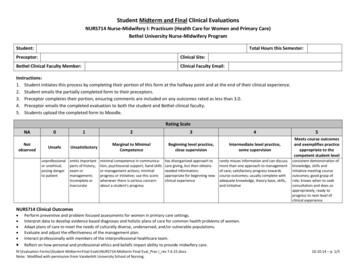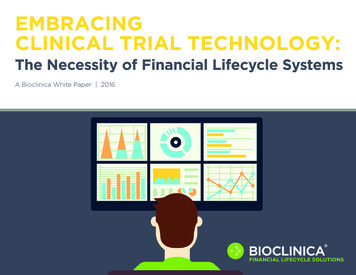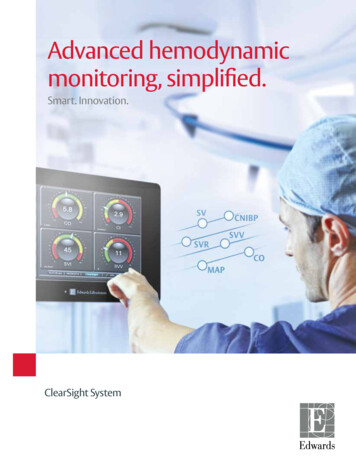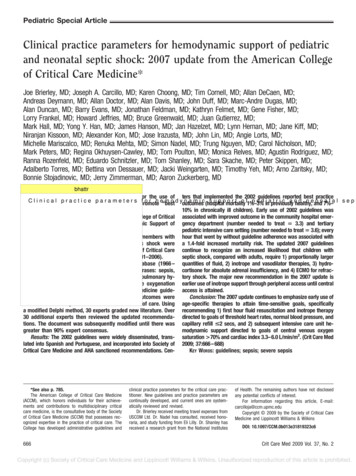
Transcription
Pediatric Special ArticleClinical practice parameters for hemodynamic support of pediatricand neonatal septic shock: 2007 update from the American Collegeof Critical Care Medicine*Joe Brierley, MD; Joseph A. Carcillo, MD; Karen Choong, MD; Tim Cornell, MD; Allan DeCaen, MD;Andreas Deymann, MD; Allan Doctor, MD; Alan Davis, MD; John Duff, MD; Marc-Andre Dugas, MD;Alan Duncan, MD; Barry Evans, MD; Jonathan Feldman, MD; Kathryn Felmet, MD; Gene Fisher, MD;Lorry Frankel, MD; Howard Jeffries, MD; Bruce Greenwald, MD; Juan Gutierrez, MD;Mark Hall, MD; Yong Y. Han, MD; James Hanson, MD; Jan Hazelzet, MD; Lynn Hernan, MD; Jane Kiff, MD;Niranjan Kissoon, MD; Alexander Kon, MD; Jose Irazusta, MD; John Lin, MD; Angie Lorts, MD;Michelle Mariscalco, MD; Renuka Mehta, MD; Simon Nadel, MD; Trung Nguyen, MD; Carol Nicholson, MD;Mark Peters, MD; Regina Okhuysen-Cawley, MD; Tom Poulton, MD; Monica Relves, MD; Agustin Rodriguez, MD;Ranna Rozenfeld, MD; Eduardo Schnitzler, MD; Tom Shanley, MD; Sara Skache, MD; Peter Skippen, MD;Adalberto Torres, MD; Bettina von Dessauer, MD; Jacki Weingarten, MD; Timothy Yeh, MD; Arno Zaritsky, MD;Bonnie Stojadinovic, MD; Jerry Zimmerman, MD; Aaron Zuckerberg, MDBackground: The Institute of Medicine calls for the use ofclinical guidelines and practice parameters to promote “bestpractices” and to improve patient outcomes.Objective: 2007 update of the 2002 American College of CriticalCare Medicine Clinical Guidelines for Hemodynamic Support ofNeonates and Children with Septic Shock.Participants: Society of Critical Care Medicine members withspecial interest in neonatal and pediatric septic shock wereidentified from general solicitation at the Society of Critical CareMedicine Educational and Scientific Symposia (2001–2006).Methods: The Pubmed/MEDLINE literature database (1966 –2006) was searched using the keywords and phrases: sepsis,septicemia, septic shock, endotoxemia, persistent pulmonary hypertension, nitric oxide, extracorporeal membrane oxygenation(ECMO), and American College of Critical Care Medicine guidelines. Best practice centers that reported best outcomes wereidentified and their practices examined as models of care. Usinga modified Delphi method, 30 experts graded new literature. Over30 additional experts then reviewed the updated recommendations. The document was subsequently modified until there wasgreater than 90% expert consensus.Results: The 2002 guidelines were widely disseminated, translated into Spanish and Portuguese, and incorporated into Society ofCritical Care Medicine and AHA sanctioned recommendations. Cen-*See also p. 785.The American College of Critical Care Medicine(ACCM), which honors individuals for their achievements and contributions to multidisciplinary criticalcare medicine, is the consultative body of the Societyof Critical Care Medicine (SCCM) that possesses recognized expertise in the practice of critical care. TheCollege has developed administrative guidelines and666ters that implemented the 2002 guidelines reported best practiceoutcomes (hospital mortality 1%–3% in previously healthy, and 7%–10% in chronically ill children). Early use of 2002 guidelines wasassociated with improved outcome in the community hospital emergency department (number needed to treat ⴝ 3.3) and tertiarypediatric intensive care setting (number needed to treat ⴝ 3.6); everyhour that went by without guideline adherence was associated witha 1.4-fold increased mortality risk. The updated 2007 guidelinescontinue to recognize an increased likelihood that children withseptic shock, compared with adults, require 1) proportionally largerquantities of fluid, 2) inotrope and vasodilator therapies, 3) hydrocortisone for absolute adrenal insufficiency, and 4) ECMO for refractory shock. The major new recommendation in the 2007 update isearlier use of inotrope support through peripheral access until centralaccess is attained.Conclusion: The 2007 update continues to emphasize early use ofage-specific therapies to attain time-sensitive goals, specificallyrecommending 1) first hour fluid resuscitation and inotrope therapydirected to goals of threshold heart rates, normal blood pressure, andcapillary refill 2 secs, and 2) subsequent intensive care unit hemodynamic support directed to goals of central venous oxygensaturation 70% and cardiac index 3.3– 6.0 L/min/m2. (Crit Care Med2009; 37:666 – 688)KEY WORDS: guidelines; sepsis; severe sepsisclinical practice parameters for the critical care practitioner. New guidelines and practice parameters arecontinually developed, and current ones are systematically reviewed and revised.Dr. Brierley received meeting travel expenses fromUSCOM Ltd. Dr. Nadel has consulted, received honoraria, and study funding from Eli Lilly. Dr. Shanley hasreceived a research grant from the National Institutesof Health. The remaining authors have not disclosedany potential conflicts of interest.For information regarding this article, E-mail:carcilloja@ccm.upmc.eduCopyright 2009 by the Society of Critical CareMedicine and Lippincott Williams & WilkinsDOI: 10.1097/CCM.0b013e31819323c6Crit Care Med 2009 Vol. 37, No. 2
Neonatal and pediatric severesepsis outcomes were alreadyimproving before 2002 withthe advent of neonatal andpediatric intensive care (reduction inmortality from 97% to 9%) (1– 4), andwere markedly better than in adults (9%compared with 28% mortality) (3). In2002, the American College of CriticalCare Medicine (ACCM) Clinical PracticeParameters for Hemodynamic Support ofPediatric and Neonatal Shock (5) werepublished, in part, to replicate the reported outcomes associated with implementation of “best clinical practices”(mortality rates of 0%–5% in previouslyhealthy [6 – 8] and 10% in chronically illchildren with septic shock [8]). There aretwo purposes served by this 2007 updateof these 2002 clinical practice parameters. First, this 2007 document examinesand grades new studies performed to testthe utility and efficacy of the 2002 recommendations. Second, this 2007 document examines and grades relevant newtreatment and outcome studies to determine to what degree, if any, the 2002guidelines should be modified.METHODSMore than 30 clinical investigators and clinicians affiliated with the Society of CriticalCare Medicine who had special interest in hemodynamic support of pediatric patients withsepsis volunteered to be members of the “update” task force. Subcommittees were formedto review and grade the literature using theevidence-based scoring system of the ACCM.The literature was accrued, in part, by searching Pubmed/MEDLINE using the followingkeywords and phrases: sepsis, septicemia, septic shock, endotoxemia, persistent pulmonaryhypertension (PPHN), nitric oxide (NO), andextracorporeal membrane oxygenation(ECMO). The search was narrowed to identifystudies specifically relevant to children. Bestpractice outcomes were identified and described; clinical practice in these centers wasused as a model.The clinical parameters and guidelineswere drafted and subsequently revised using amodification of the Delphi method. Briefly,the initial step included review of the literature and grading of the evidence by topicbased subcommittees during a 6-month period. Subcommittees were formed accordingto participant interest in each subtopic. Theupdate recommendations from each subcommittee were incorporated into the preexisting2002 document by the task force chairperson.All members commented on the unified update draft, and modifications were made in anCrit Care Med 2009 Vol. 37, No. 2Table 1. American College of Critical Care Medicine guidelines for evidence-based medicine ratingsystem for strength of recommendation and quality of evidence supporting the referencesRating system for referencesaRandomized, prospective controlled trialbNonrandomized, concurrent or historical cohort investigationscPeer-reviewed, state of the art articles, review articles, editorials, or substantialcase seriesdNonpeer reviewed published opinions, such as textbook statements or officialorganizational publicationsRating system for recommendationsLevel 1Convincingly justifiable on scientific evidence aloneLevel 2Reasonably justifiable by scientific evidence and strongly supported by expert criticalcare opinionLevel 3Adequate scientific evidence is lacking but widely supported by available data andexpert opinioniterative fashion until 10% of the task forcedisagreed with any specific or general recommendation. This process occurred during a1-year period. Reviewers from the ACCM thenrequested further modifications that wereconsidered for inclusion if supported by evidence and best practice. Grading of the literature and levels of recommendations werebased on published ACCM criteria (Table 1).RESULTSSuccessful Dissemination,Acceptance, Implementation,and Outcome of 2002GuidelinesThe 2002 guidelines were initially distributed in the English language with official sanctioning by the Society for Critical Care Medicine with publication inCritical Care Medicine. The main pediatric algorithm was included in the Pediatric Advanced Life Support (PALS) manualpublished by the American Heart Association. In addition, the pediatric and newborn treatment algorithms were published in whole or part in multipletextbooks. The guidelines were subsequently published in Spanish and Portuguese allowing for dissemination inmuch of the American continents. Therehave been 57 peer-reviewed publicationssince 2002 that have cited these guidelines. Taken together these findings demonstrate academic acceptance and dissemination of the 2002 guidelines (Tables2 and 3).Many studies have tested the observations and recommendations of the 2002guidelines. These studies reported evidence that the guidelines were useful andeffective without any evidence of harm.For example, Wills et al (9) demonstratednear 100% survival when fluid resuscitation was provided to children with den-gue shock. Maitland et al (10) demonstrated a reduction in mortality frommalaria shock from 18% to 4% whenalbumin was used for fluid resuscitationrather than crystalloid. Han et al reportedan association between early use of practice consistent with the 2002 guidelinesin the community hospital and improvedoutcomes in newborns and children(mortality rate 8% vs. 38%; numberneeded to treat [NNT] 3.3). Every hourthat went by without restoration of normal blood pressure for age and capillaryrefill 3 secs was associated with a twofold increase in adjusted mortality oddsratio (11). Ninis et al (12) similarly reported an association between delay ininotrope resuscitation and a 22.6-foldincreased adjusted mortality odds ratio inmeningococcal septic shock. In a randomized controlled study, Oliveira et al(13) reported that use of the 2002 guidelines with continuous central venous oxygen saturation (ScvO2) monitoring, andtherapy directed to maintenance of ScvO2 70%, reduced mortality from 39% to12% (NNT 3.6). In a before and afterstudy, Lin et al (14) reported that implementation of the 2002 guidelines in aU.S. tertiary center achieved best practiceoutcome with a fluid refractory shock 28day mortality of 3% and hospital mortality of 6% (3% in previously healthy children; 9% in chronically ill children). Thisoutcome matched the best practice outcomes targeted by the 2002 guidelines(6 – 8). Similar to the experience of St.Mary’s Hospital before 2002 (7), SophiaChildren’s Hospital in Rotterdam also recently reported a reduction in mortalityrate from purpura and severe sepsis from20% to 1% after implementation of 2002guideline-based therapy in the referralcenter, transport system, and tertiarycare settings (15). Both of these centers667
Table 2. American College of Critical Care Medicine hemodynamic definitions of shockCold or warm holamine-resistantshockRefractory shockDecreased perfusion manifested by altered decreased mental status,capillary refill 2 secs (cold shock) or flash capillary refill(warm shock), diminished (cold shock) or bounding (warmshock) peripheral pulses, mottled cool extremities (cold shock),or decreased urine output 1 mL/kg/hShock persists despite ⱖ60 mL/kg fluid resuscitation (whenappropriate) and dopamine infusion to 10 g/kg/minShock persists despite use of the direct-acting catecholamines;epinephrine or norepinephrineShock persists despite goal-directed use of inotropic agents,vasopressors, vasodilators, and maintenance of metabolic(glucose and calcium) and hormonal (thyroid, hydrocortisone,insulin) homeostasisTable 3. Threshold heart rates and perfusion pressure mean arterial pressure-central venous pressure or mean arterial pressure-intra-abdominalpressure for ageMean ArterialPressure-CentralHeartVenous PressureThreshold Rates Rate (bpm)(mm Hg)Term newbornUp to 1 yrUp to 2 yrsUp to 7 yrsUp to 15 0656565bpm, beats per minute.Modified from The Harriet Lane Handbook.Thirteenth Edition and National Heart, Lung,and Blood Institute, Bethesda. MD: Report of thesecond task force on blood pressure control inchildren - 1987 (306, 307).also used high flux continuous renal replacement therapy (CRRT) and fresh frozenplasma infusion directed to the goal of normal international normalized ratio (INR)(prothrombin time). In a U.S. child healthoutcomes database (Kids’ Inpatient Database or KID) analysis, hospital mortalityfrom severe sepsis was recently estimatedto be 4.2% (2.3% in previously healthy children, and 7.8% in children with chronicillness) (16), a decrease compared with 9%in 1999 (4). Taken together, these studiesindirectly and directly support the utilityand efficacy of implementation of the timesensitive, goal-directed recommendationsof the 2002 guidelines in the emergency/delivery room and pediatric intensive careunit/neonatal intensive care unit settings.New Major Recommendationsin the 2007 UpdateBecause of the success of the 2002guidelines, the 2007 update compilation668and discussion of the new literature weredirected to the question of what changes,if any, should be implemented in the update. The members of the committeewere asked whether there are clinicalpractices which the best outcome practices are using in 2007 that were notrecommended in the 2002 guidelines andshould be recommended in the 2007guidelines? The changes recommendedwere few. Most importantly, there was nochange in emphasis between the 2002guidelines and the 2007 update. The continued emphasis is directed to: 1) firsthour fluid resuscitation and inotropedrug therapy directed to goals of threshold heart rates (HR), normal blood pressure, and capillary refill ⱕ2 secs, and 2)subsequent intensive care unit hemodynamic support directed to goals of ScvO2 70% and cardiac index 3.3– 6.0 L/min/m2. New recommendations in the 2007update include the following: 1) The 2002guidelines recommended not giving cardiovascular agents until central vascularaccess was attained. This was becausethere was and still is concern that administration of peripheral vasoactive agents(especially vasopressors) could result inperipheral vascular/tissue injury. However, after implementation of the 2002guidelines, the literature showed that, depending on availability of skilled personnel, it could take two or more hours toestablish central access. Because mortality went up with delay in time to inotropedrug use, the 2007 update now recommends use of peripheral inotropes (notvasopressors) until central access is attained. The committee continues to recommend close monitoring of the peripheral access site to prevent peripheralvascular/tissue injury; 2) The 2002 guidelines made no recommendations on whatsedative/analgesic agent(s) to use to facil-itate placement of central lines and/orintubation. Multiple editorials and cohortstudies have since reported that the useof etomidate was associated with increased severity of illness adjusted mortality in adults and children with septicshock. The 2007 update now states thatetomidate is not recommended for children with septic shock unless it is used ina randomized controlled trial format. Fornow, the majority of the committee usesatropine and ketamine for invasive procedures in children with septic shock.Little experience is available with ketamine use in newborn septic shock andthe committee makes no recommendation in this population; 3) Since 2002,cardiac output (CO) can be measured notonly with a pulmonary artery catheter,but also with Doppler echocardiography,or a pulse index contour cardiac outputcatheter catheter, or a femoral arterythermodilution catheter. Titration of therapy to CO 3.3– 6.0 L/min/m2 remains thegoal in patients with persistent catecholamine resistant shock in 2007 guidelines.Doppler echocardiography can also beused to direct therapies to a goal of superior vena cava (SVC) flow 40 mL/min/kg in very low birth weight (VLBW)infants; 4) There are several new potential rescue therapies reported since the2002 guidelines. In children, enoximoneand levosimendan have been highlightedin case series and case reports. Unlikevasopressin, which had been suggested bysome as a vasoplegia rescue therapy,these agents are suggested by some asrecalcitrant cardiogenic shock rescueagents. In newborns, inhaled prostacyclinand intravenous (IV) adenosine were reportedly successful in refractory PPHN.The 2007 update recommends furtherevaluation of these new agents in appropriate patient settings; and 5) The 2002guidelines made no recommendation onfluid removal. Although fluid resuscitation remains the hallmark and first stepof septic shock resuscitation, two cohortstudies showed the importance of fluidremoval in fluid overloaded septic shock/multiple organ failure patients. The 2007update recommends that fluid removalusing diuretics, peritoneal dialysis, orCRRT is indicated in patients who havebeen adequately fluid resuscitated butcannot maintain subsequent even-fluidbalance through native urine output.This can be done when such patients develop new onset hepatomegaly, rales, or10% body weight fluid overload.Crit Care Med 2009 Vol. 37, No. 2
Literature and Best PracticeReviewDevelopmental Differences in the Hemodynamic Response to Sepsis in Newborns, Children, and Adults. The predominant cause of mortality in adult septicshock is vasomotor paralysis (17). Adultshave myocardial dysfunction manifestedas a decreased ejection fraction; however,CO is usually maintained or increased bytwo mechanisms: tachycardia and reduced systemic vascular resistance (SVR).Adults who do not develop this process tomaintain CO have a poor prognosis (18,19). Pediatric septic shock is associatedwith severe hypovolemia, and childrenfrequently respond well to aggressive volume resuscitation; however, the hemodynamic response of fluid resuscitated vasoactive-dependent children seems diversecompared with adults. Contrary to theadult experience, low CO, not low SVR, isassociated with mortality in pediatric septic shock (20 –29). Attainment of thetherapeutic goal of CI 3.3– 6.0 L/min/m2may result in improved survival (21, 29).Also contrary to adults, a reduction inoxygen delivery rather than a defect inoxygen extraction, can be the major determinant of oxygen consumption inchildren (22). Attainment of the therapeutic goal of oxygen consumption (VO2) 200 mL/min/m2 may also be associatedwith improved outcome (21).It was not until 1998 that investigators reported patient outcome when aggressive volume resuscitation (60 mL/kgfluid in the first hour) and goal-directedtherapies (goal, CI 3.3– 6.0 L/min/m2 andnormal pulmonary capillary wedge pressure) (21) were applied to children withseptic shock (29). Ceneviva et al (29) reported 50 children with fluid-refractory(ⱖ60 mL/kg in the first hour), dopamineresistant shock. The majority (58%)showed a low CO/high SVR state, and22% had low CO and low vascular resistance. Hemodynamic states frequentlyprogressed and changed during the first48 hrs. Persistent shock occurred in 33%of the patients. There was a significantdecrease in cardiac function over time,requiring addition of inotropes and vasodilators. Although decreasing cardiacfunction accounted for the majority ofpatients with persistent shock, someshowed a complete change from a lowoutput state to a high output/low SVRstate (30 –33). Inotropes, vasopressors,and vasodilators were directed to maintain normal CI and SVR in the patients.Crit Care Med 2009 Vol. 37, No. 2Mortality from fluid-refractory, dopamineresistant septic shock in this study (18%)was markedly reduced compared withmortality in the 1985 study (58%) (29), inwhich aggressive fluid resuscitation wasnot used. Since 2002, investigators haveused Doppler ultrasound to measure CO(34), and similarly reported that previously healthy children with meningococcemia often had a low CO with a highmortality rate, whereas CO was high andmortality rate was low in septic shockrelated to catheter-associated bloodstream infections.Neonatal septic shock can be complicated by the physiologic transition fromfetal to neonatal circulation. In utero,85% of fetal circulation bypasses thelungs through the ductus arteriosus andforamen ovale. This flow pattern is maintained by suprasystemic pulmonary vascular resistance in the prenatal period. Atbirth, inhalation of oxygen triggers a cascade of biochemical events that ultimately result in reduction in pulmonaryvascular resistance and artery pressureand transition from fetal to neonatal circulation with blood flow now being directed through the pulmonary circulation. Closure of the ductus arteriosus andforamen ovale complete this transition.Pulmonary vascular resistance and arterypressures can remain elevated and theductus arteriosus can remain open forthe first 6 wks of life, whereas the foramen ovale may remain probe patent foryears. Sepsis-induced acidosis and hypoxia can increase pulmonary vascular resistance and thus arterial pressure andmaintain patency of the ductus arteriosus, resulting in PPHN of the newbornand persistent fetal circulation. Neonatalseptic shock with PPHN can be associatedwith increased right ventricle work. Despite in utero conditioning, the thickenedright ventricle may fail in the presence ofsystemic pulmonary artery pressures. Decompensated right ventricular failure canbe clinically manifested by tricuspid regurgitation and hepatomegaly. Newbornanimal models of group B streptococcaland endotoxin shock have also documented reduced CO, and increased pulmonary, mesenteric, and SVR (35–39).Therapies directed at reversal of rightventricle failure, through reduction ofpulmonary artery pressures, are commonly needed in neonates with fluidrefractory shock and PPHN.The hemodynamic response in premature, VLBW infants with septic shock( 32 wks gestation, 1000 g) is leastunderstood. Most hemodynamic information is derived only from echocardiographic evaluation and there are few septic shock studies in this population.Neonatology investigators often fold septic shock patients into “respiratory distress syndrome” and “shock” studiesrather than conduct septic shock studiesalone. Hence, the available clinical evidenceon the hemodynamic response in premature infants for the most part is in babieswith respiratory distress syndrome orshock of undescribed etiology. In the first24 hrs after birth during the “transitionalphase,” the neonatal heart must rapidly adjust to a high vascular resistance state compared with the low resistance placenta. COand blood pressure may decrease when vascular resistance is increased (40). However,the literature indicates that premature infants with shock can respond to volumeand inotropic therapies with improvedstroke volume (SV), contractility, and bloodpressure (41–54).Several other developmental considerations influence shock therapy in the premature infant. Relative initial deficiencies in the thyroid and parathyroidhormone axes have been reported andcan result in the need for thyroid hormone and/or calcium replacement.(55,56) Hydrocortisone has been examined inthis population as well. Since 2002, randomized controlled trials showed thatprophylactic use of hydrocortisone on day1 of life reduced the incidence of hypotension in this population, (57) and a7-day course of hydrocortisone reducedthe need for inotropes in VLBW infantswith septic shock (58 – 60). Immaturemechanisms of thermogenesis require attention to external warming. Reducedglycogen stores and muscle mass for gluconeogenesis require attention to maintenance of serum glucose concentration.Standard practices in resuscitation ofpreterm infants in septic shock use amore graded approach to volume resuscitation and vasopressor therapy compared with resuscitation of term neonatesand children. This more cautious approach is a response to anecdotal reportsthat preterm infants at risk for intraventricular hemorrhage ( 30 wks gestation)can develop hemorrhage after rapid shiftsin blood pressure; however, some nowquestion whether long-term neurologicoutcomes are related to periventricularleukomalacia (a result of prolonged under perfusion) more than to intraventricular hemorrhage. Another complicatingfactor in VLBW infants is the persistence669
of the patent ductus arteriosus. This canoccur because immature muscle is lessable to constrict. The majority of infantswith this condition are treated medicallywith indomethacin, or in some circumstances with surgical ligation. Rapid administration of fluid may further increaseleft to right shunting through the ductuswith ensuant pulmonary edema.One single-center randomized controltrial reported improved outcome with useof daily 6-hr pentoxyfilline infusions invery premature infants with sepsis (61,62). This compound is both a vasodilatorand an anti-inflammatory agent. A Cochrane analysis agrees that this promising therapy deserves evaluation in a multicentered trial setting (63).What Clinical Signs andHemodynamic Variables Can beUsed to Direct Treatment ofNewborn and Pediatric Shock?Shock can be defined by clinical variables, hemodynamic variables, oxygenutilization variables, and/or cellular variables; however, after review of the literature, the committee continues to chooseto define septic shock by clinical, hemodynamic, and oxygen utilization variablesonly. This decision may change at thenext update. For example, studies demonstrate that blood troponin concentrations correlate well with poor cardiacfunction and response to inotropic support in children with septic shock (64 –66). Lactate is recommended in adultseptic shock laboratory testing bundlesfor both diagnosis and subsequent monitoring of therapeutic responses. However, most adult literature continues todefine shock by clinical hypotension, andrecommends using lactate concentrationto identify shock in normotensive adults.For now the overall committee recommends early recognition of pediatric septic shock using clinical examination, notbiochemical tests. Two members dissentfrom this recommendation and suggestuse of lactate as well.Ideally, shock should be clinically diagnosed before hypotension occurs byclinical signs, which include hypothermia or hyperthermia, altered mental status, and peripheral vasodilation (warmshock) or vasoconstriction with capillaryrefill 2 secs (cold shock). Threshold HRassociated with increased mortality incritically ill (not necessarily septic) infants are a HR 90 beats per minute(bpm) or 160 bpm, and in children are670a HR 70 bpm or 150 bpm (67). Emergency department therapies should be directed toward restoring normal mentalstatus, threshold HRs, peripheral perfusion (capillary refill 3 secs), palpabledistal pulses, and normal blood pressurefor age (Table 3) (11). Orr et al reportedthat specific hemodynamic abnormalitiesin the emergency department were associated with progressive mortality (in parenthesis); eucardia (1%) tachycardia/bradycardia (3%) hypotension withcapillary refill 3 secs (5%) normotension with capillary refill greater than 3secs (7%) hypotension with capillaryrefill greater than 3 secs (33%). Reversalof these hemodynamic abnormalities using ACCM/PALS recommended therapywas associated with a 40% reduction inmortality odds ratio regardless of thestage of hemodynamic abnormality at thetime of presentation (68). One member ofthe committee wishes to emphasize thatthese signs are important only if the patients are considered ill.In both neonates and children, shockshould be further evaluated and resuscitation treatment guided by hemodynamicvariables including perfusion pressure(mean arterial pressure [MAP] minuscentral venous pressure) and CO. As previously noted, blood flow (Q) varies directly with perfusion pressure (dP) andinversely with resistance (R). This ismathematically represented by Q dP/R.For the systemic circulation this is represented by CO (MAP central venouspressure)/SVR. This relationship is important for organ perfusion. In the kidney, for example, renal blood flow (mean renal arterial pressure meanrenal venous pressure)/renal vascular resistance. The kidney and brain have vasomotor autoregulation, which maintainsblood flow in low blood pressure (MAP orrenal arterial pressure) states. At somecritical point, perfusion pressure is reduced below the ability of the organ tomaintain blood flow.One goal of shock treatment is tomaintain perfusion pressure above thecritical point below which blood flow cannot be effectively maintained in individual organs. The kidney receives the second highest blood flow relative to itsmass of any organ in the body, and measurement of urine output (with the exception of patients with hyperosmolarstates such as hyperglycemia which leadsto osmotic diuresis) and creatinine clearance can be used as an indicator of adequate blood flow and perfusion pressure.Maintenance of MAP with norepinephrinehas been shown to improve urine outputand creatinine clearance in hyperdynamic sepsis (69). Producing a supranormal MAP above this point is likely not ofbene
ments and contributions to multidisciplinary critical care medicine, is the consultative body of the Society of Critical Care Medicine (SCCM) that possesses rec-ognized expertise in the practice of critical care. The College has developed administrative guidelines and clinical practice paramet



